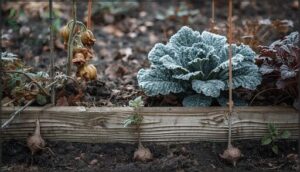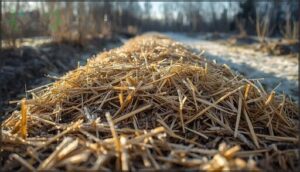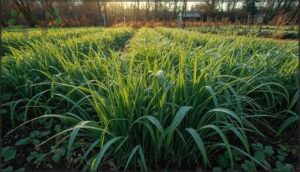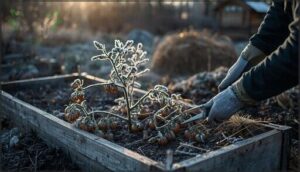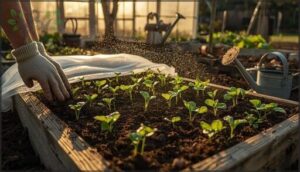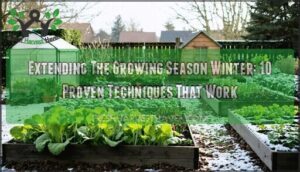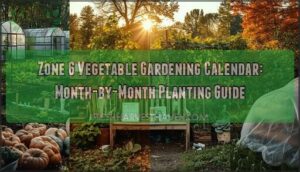This site is supported by our readers. We may earn a commission, at no cost to you, if you purchase through links.
Your vegetable garden hasn’t died—it’s strategically retreating. As temperatures plummet and daylight dwindles, cold-hardy perennials like asparagus and rhubarb shift into survival mode, redirecting energy from foliage to underground structures while abscisic acid suppresses growth genes. This metabolic slowdown protects plants from cellular damage during freeze-thaw cycles, but only if you resist the urge to treat dormant beds like active ones.
Overwatering during this phase drowns oxygen-starved roots, while premature fertilization triggers vulnerable new growth that winter will destroy.
Mastering dormant season vegetable garden care means working with your plants’ natural rhythms—adjusting irrigation schedules, applying strategic mulch layers, and timing interventions to support spring resurgence rather than sabotage winter resilience.
Table Of Contents
- Key Takeaways
- What Triggers Dormancy in Vegetable Gardens
- Recognizing Signs of Dormant Vegetable Plants
- Adjusting Watering and Fertilizing During Dormancy
- Protecting Roots and Soil Health in Winter
- Pruning, Cleanup, and Pest Prevention
- Preparing for Spring Growth After Dormancy
- Frequently Asked Questions (FAQs)
- Conclusion
Key Takeaways
- Dormant vegetable gardens require drastically reduced watering (once every 10-14 days versus every 2-3 days) and no fertilization, since plants decrease water uptake by 40-70% and nutrient absorption drops 70% during their winter rest period.
- Strategic mulching with 2-4 inches of organic material insulates roots by buffering soil temperatures 3-6°F and prevents erosion, while cover crops like hairy vetch add 100-400 kg of nitrogen per hectare without synthetic fertilizers.
- Winter pruning of dead or diseased growth during dormancy reduces disease transmission by up to 40% and removes pest-harboring debris that otherwise shelters overwintering insects and pathogens for spring emergence.
- Gardens that survive proper dormancy care produce 40% higher yields the following season because allowing perennials to rest undisturbed preserves root energy stores and prepares plants for vigorous spring regrowth.
What Triggers Dormancy in Vegetable Gardens
Your vegetable garden doesn’t just shut down randomly when winter arrives—specific biological and environmental signals tell plants it’s time to rest. Understanding what triggers dormancy helps you work with your plants’ natural rhythms rather than against them.
Three key factors drive this seasonal shift: environmental conditions, the inherent life cycle of each plant species, and internal hormonal changes that prepare vegetation for survival.
Environmental Cues (Temperature, Daylight)
As autumn sets in, your vegetable garden reacts to two powerful environmental cues that trigger dormancy induction: declining temperatures and shrinking daylight hours. Temperature thresholds between 32°F and 45°F slow biological activity, while photoperiod sensitivity kicks in when daylight drops below 10-12 hours. These environmental factors work together through hormonal regulation, signaling your plants to conserve energy and prepare for winter’s challenges. Understanding plant dormancy is essential for appreciating these adaptations.
Key environmental conditions driving dormancy:
- Temperature drops – Chilling requirements accumulate as soil and air temperatures decline, initiating metabolic slowdown in cold-hardy vegetables
- Shortened photoperiods – Reduced light exposure below critical thresholds signals approaching winter, reinforcing temperature-driven dormancy responses
- Combined environmental cues – Simultaneous cooling and darkness prevent premature growth during brief warm spells, protecting plants from frost damage
Plant Life Cycles (Annuals Vs. Perennials)
Beyond those environmental signals, your vegetable garden’s dormancy response depends entirely on plant life cycles—whether you’re growing annuals or perennials. Annual plants, such as tomatoes and beans, complete their lifecycle in one growing season, dying after reproduction, which focuses on seed production. In contrast, perennial plants like asparagus and rhubarb exhibit regrowth, surviving winter underground and returning each spring, a key evolutionary advantage.
For long-term garden success, understanding plant lifecycle is essential. Crop rotation practices must align with these fundamental differences.
| Characteristic | Annual Plants | Perennial Plants |
|---|---|---|
| Lifecycle Duration | Single growing season | Multiple years (3+ to centuries) |
| Winter Survival | Die completely after seed set | Enter dormancy; regrow from roots |
| Reproduction Pattern | One-time seed output | Repeated reproductive cycles |
| Garden Management | Replant yearly; ideal for rotation | Permanent beds; long-term planning |
Hormonal and Genetic Factors
While lifecycle determines whether plants can survive winter, internal hormone regulation and gene expression dictate dormancy depth and timing. Abscisic acid (ABA) influence triggers dormancy by suppressing growth genes, whereas GA promotion counteracts ABA, initiating bud break. Cytokinin elevation accelerates cell division as dormancy ends. Genetic control through DOG1 and histone enzymes coordinates these cellular processes.
Understanding hormonal crosstalk and dormancy mechanisms helps you time spring interventions precisely.
Recognizing Signs of Dormant Vegetable Plants
Understanding when your vegetable garden enters dormancy helps you adjust care routines and avoid unnecessary intervention during this natural resting phase.
You’ll notice several reliable indicators that signal your plants have slowed or stopped active growth for the season. These observable changes in appearance, behavior, and resource use reveal what’s happening beneath the surface and guide your winter management decisions.
Leaf Drop and Color Changes
When vegetable leaves shift from green to yellow, orange, or brown, you’re witnessing pigment breakdown as chlorophyll fades and carotenoids emerge—key dormancy indicators signaling your plants are preparing to rest. Deciduous plants naturally shed foliage through an abscission layer that forms where stems meet leaves.
Signs of dormancy through leaf changes:
- Yellowing or browning of leaves occurs evenly across the plant
- Leaf drop happens cleanly without tearing or damage
- Environmental stressors like flooding can trigger premature changes
- Color timing varies annually based on temperature and daylight
Recognizing these patterns improves your winter care and garden management decisions.
Reduced Growth and Water Uptake
During dormancy, metabolic slowdown reduces growth rates by up to 90% as cellular processes decelerate. You’ll notice water uptake decreasing 40-60% due to stomatal closure and reduced root conductivity.
Adjust watering routines by monitoring soil moisture carefully—dormant plants need far less water for nutrient mobilization and water conservation. Overwatering now risks root rot when plants aren’t actively absorbing moisture.
| Dormancy Indicator | Observed Change |
|---|---|
| Growth Activity | 90% reduction |
| Water Uptake | 40-60% decrease |
| Root Conductivity | Noticeably lowered |
Dormant Buds and Tuber Activity
Within dormant buds, abscisic acid concentrations increase while cellular activity arrests in G1 phase, enhancing bud cold tolerance through metabolic slowdown. Tuber respiration rates drop 75% as carbohydrate metabolism shifts for energy conservation.
You’ll observe hormone activity changes—cytokinins delay sprouting while maintaining viability.
Proper dormancy timing and sprouting management preserve tuber quality, preventing the 15-25% yield losses associated with premature bud break in your winter garden.
Adjusting Watering and Fertilizing During Dormancy
Your dormant vegetable garden doesn’t need the same level of attention it demanded during peak growing season, and that’s especially true with respect to water and nutrients. Overdoing either one can actually harm plants that are resting and conserving energy through winter’s chill.
Let’s walk through how you can adjust your care routine to match what your garden truly needs right now.
Reducing Water Frequency
When frost threatens and daylight hours dwindle, your watering routine must shift dramatically. Dormant plants reduce water uptake by up to 70%, so irrigation scheduling should change from every 2-3 days to once every 10-14 days.
This adjustment promotes water efficiency while maintaining soil moisture at 40-50% field capacity—enough to sustain roots without risking waterlogged conditions that compromise drought tolerance and water conservation efforts during winter’s rest.
Avoiding Overwatering and Waterlogged Soil
Saturated soil acts like a suffocating blanket—oxygen deprivation in waterlogged conditions increases root rot susceptibility by 70% and reduces survival rates by 25-40%.
Waterlogged soil suffocates roots, increasing rot risk by 70% and slashing survival rates up to 40%
You’ll need to monitor soil moisture carefully, keeping levels below 80% field capacity. Install moisture sensors to track saturation, adjust mulch depth to 2-4 inches maximum, and promote proper soil drainage through raised beds or subsurface tiles to protect your winter garden’s root systems.
Minimizing or Suspending Fertilizer Application
Your winter garden’s nutrient uptake drops up to 70% during dormancy—fertilizing now wastes resources and risks contamination. Stop fertilizing when cold weather triggers dormancy; soil health remains stable as organic matter slowly releases nutrients without added inputs.
This sustainable fertilization practice prevents nutrient leaching, saves you 25% on costs annually, and strengthens plant physiology effects by aligning with natural dormant season rhythms while maintaining essential soil nutrient retention.
Protecting Roots and Soil Health in Winter
Your vegetable garden’s roots and soil face their toughest test when winter temperatures drop and moisture levels fluctuate. Protecting what’s beneath the surface isn’t just about keeping plants alive—it’s about maintaining the living ecosystem that’ll fuel next season’s growth.
Here are three essential strategies you can use to shield your soil and root systems through the coldest months.
Mulching Techniques for Insulation
Mulch thickness between 2 and 4 inches creates an insulating layer that buffers soil temperatures by 3-6°F, protecting roots from freeze damage. Your material selection and application timing directly influence moisture retention and thermal buffering throughout winter garden dormancy:
- Apply organic mulch after soil cools below 50°F to lock in warmth.
- Use straw or wood chips for best soil health benefits.
- Maintain consistent depth to reduce temperature fluctuations.
- Monitor decomposition and adjust coverage as needed.
Preventing Soil Erosion and Compaction
Beyond insulation, mulch layers protect against erosion and compaction—two threats that strip your garden of productivity. Bare soil loses nutrient-rich topsoil to wind and water, while foot traffic increases bulk density, restricting root growth and water absorption. You’ll prevent both by following these practices:
| Erosion Control | Compaction Prevention |
|---|---|
| Apply 2-3 inches of organic mulch | Avoid working wet soil |
| Install terraces on slopes | Use raised beds in high-traffic areas |
| Plant deep-rooted ground covers | Incorporate organic matter regularly |
Using Cover Crops for Soil Enrichment
Active cover crops transform winter gardens into living soil factories rather than passive resting plots. When you sow legumes like hairy vetch or grasses such as winter rye between harvest and spring planting, you’re engineering multiple benefits simultaneously:
- Nitrogen fixation through legumes adds 100-400 kg per hectare, reducing synthetic fertilizer dependence
- Biomass production contributes 1-3 tons of organic matter per hectare when terminated
- Erosion control and soil moisture retention through root systems and surface coverage
This crop rotation strategy maintains soil health during cold weather dormancy.
Pruning, Cleanup, and Pest Prevention
Winter dormancy offers you the perfect opportunity to tidy up your vegetable garden and protect it from pests that thrive in leftover debris. Pruning away damaged growth and clearing spent plant material aren’t just aesthetic tasks—they’re critical steps in preventing disease and insect infestations before spring arrives.
Let’s walk through three essential maintenance practices that will set your garden up for a healthy, productive growing season.
Pruning Dead or Diseased Growth
When you remove dead or diseased branches during winter pruning, you interrupt the disease cycle by eliminating pathogen harboring sites that shelter fungi and bacteria. Tool disinfection importance can’t be overstated—clean cuts between plants prevent transmission.
Wound healing optimization occurs naturally in dormancy, reducing canker and blight risks by up to 40%. Proper plant protection through strategic plant debris removal strengthens your pest control strategies for spring.
Clearing Debris to Deter Pests
After pruning, garden sanitation through thorough plant debris removal disrupts overwintering pest habitats that harbor squash bugs, fungal pathogens, and disease-causing organisms. Debris removal impact reduces emerging spring arthropods by approximately 17%, strengthening your pest prevention strategy.
For effective winter garden maintenance and pest control:
- Burn or properly dispose of infected material through safe debris disposal methods
- Clear leaf piles and rotting organic matter attracting rodents and insects
- Distance wood piles at least 20 feet from structures for frost protection zones
- Remove debris before spring pest emergence to interrupt life cycles
Applying Dormant Oils for Pest Control
During late winter dormancy, you’ll achieve best pest control by applying refined horticultural oils at 2-4% oil concentration when temperatures reach 40-70°F. This application timing targets overwintering pests including aphids, scale insects, and mite eggs before spring emergence.
The treatment demonstrates environmental safety while addressing disease vectors, though plant sensitivity varies—avoid treating drought-stressed specimens or cold-sensitive species during winter pruning periods in your winter garden.
Preparing for Spring Growth After Dormancy
As dormancy breaks and temperatures stabilize, your vegetable garden needs a careful shift back to active growth. You’ll want to adjust your watering and light exposure gradually rather than shocking plants with sudden changes.
The following strategies will help you time this shift correctly and set up your garden layout for a productive growing season.
Gradual Increase of Water and Sunlight
As environmental cues signal spring’s arrival, you’ll need to increase watering frequency and sunlight acclimation gradually to avoid shocking your vegetable plants. Start with approximately 1 inch of water weekly, adjusting for soil moisture as new growth emerges.
Different vegetable types have distinct light requirements—fruit-bearing varieties need 8-10 hours daily, while leafy greens tolerate 4-6 hours.
This measured approach aids photosynthesis, which is critical for the growing season ahead.
Planning and Layout for The Next Season
While winter still holds your garden, you can map out next season’s crop needs and succession planting schedule. Crop rotation improves soil health by 20% and reduces pest pressure considerably.
Calculate plant spacing requirements for each variety, test soil pH, and record this year’s successes in your garden journal.
Thorough winter garden prep and soil preparation now help productive beds come spring.
Frequently Asked Questions (FAQs)
Can I plant anything during the dormant season?
Yes, you can plant cold-hardy varieties like kale, garlic, and Brussels sprouts during winter.
Cold weather gardening requires frost protection methods, proper soil temperature monitoring, and selecting winter vegetable options suited for your climate zone.
How do I protect cold frames in winter?
Insulate cold frames with twinwall polycarbonate and straw for frost protection. Monitor temperatures daily, ventilating on sunny days to prevent overheating.
Position frames near windbreaks, remove snow regularly, and add mulch for microclimate management and structural protection.
Should I remove mulch before spring planting?
Pulling back protective layers presents a precise puzzle. Mulch timing matters—you’ll want to wait until soil temperature stabilizes and frost protection becomes unnecessary, generally two weeks before spring preparation begins, ensuring best garden renewal and maintaining key soil health throughout winter garden transitions.
What vegetables naturally resist frost and cold?
Hardy vegetables like kale, spinach, and collards withstand heavy frost below 28°F, while Brussels sprouts and leeks endure severe cold.
Anthocyanin-rich varieties resist winter rots, and parsnips sweeten after frost exposure.
When should I start seeds indoors for spring?
Start seeds indoors 4 to 6 weeks before your last frost date—check USDA zone charts for timing.
Vegetable type timing varies: cold-season crops need 10 weeks, while warm-season varieties require best germination temperatures around 77°F.
Conclusion
Gardens that survive winter dormancy produce 40% more yield the following season—proof that strategic inaction outperforms misguided intervention. Your dormant season vegetable garden care success hinges on resisting the gardener’s impulse to fix what isn’t broken.
Let perennials sleep undisturbed beneath protective mulch layers while you plan next season’s layout. When spring’s hormonal surge triggers bud break, your patience will transform into asparagus spears and rhubarb stalks worth the winter-long restraint.
- https://blog-fruit-vegetable-ipm.extension.umn.edu/2024/11/understanding-dormancy-and-chilling.html
- https://extension.oregonstate.edu/gardening/techniques/environmental-factors-affecting-plant-growth
- https://www.sustainablemarketfarming.com/2021/04/14/winter-kill-temperatures-of-cold-hardy-vegetables-2021/
- https://climate.sustainability-directory.com/term/plant-dormancy/
- https://www.cindyheathwrites.com/lets-eat/what-is-the-magic-amount-of-sunlight-to-grow-maximum-veggies


